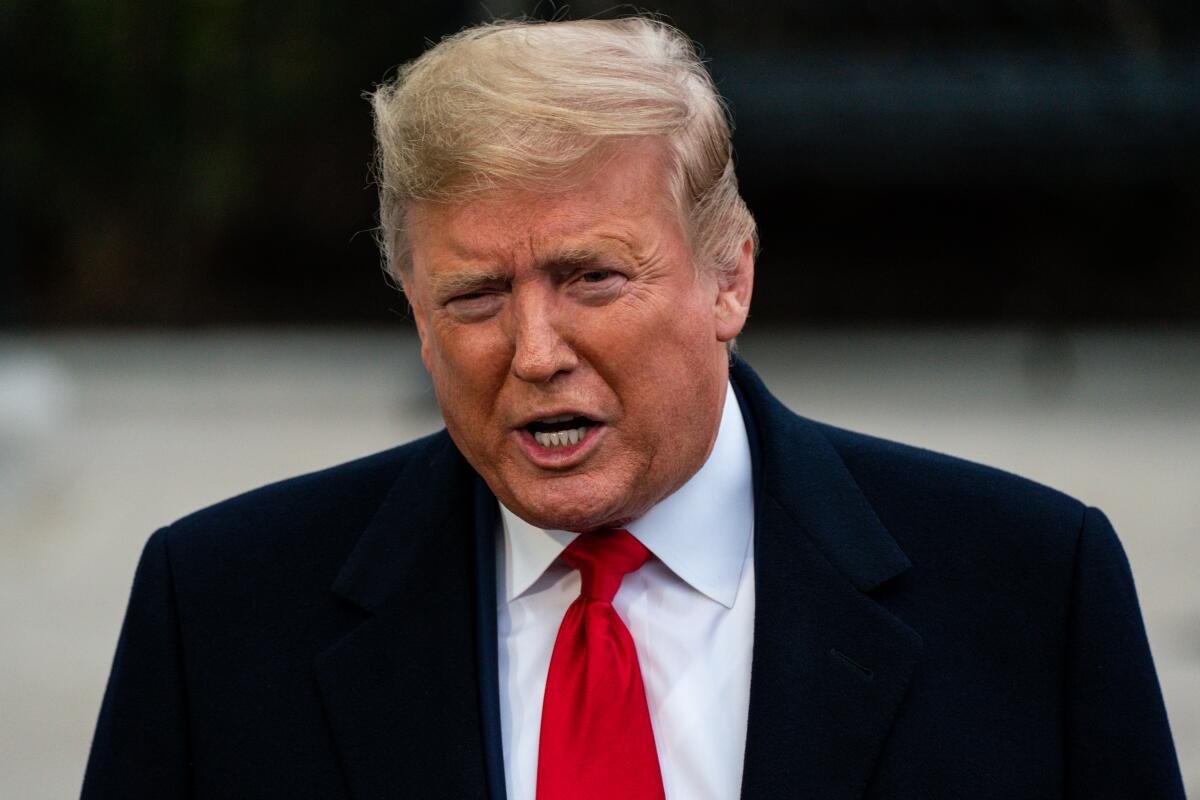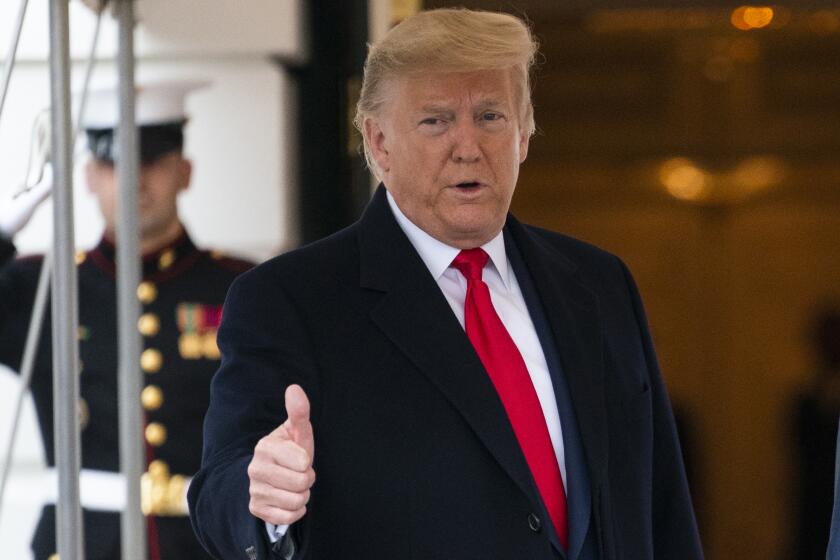Trump unveils $4.8-trillion budget that resurrects rejected cuts

- Share via
WASHINGTON — President Trump unveiled a $4.8-trillion election-year budget plan Monday that recycles previously rejected cuts to domestic programs such as food stamps and Medicaid to promise a balanced budget in 15 years — all while leaving Social Security and Medicare benefits untouched.
Trump’s fiscal 2021 plan promises the government’s deficit will crest above $1 trillion only for the current budget year before steadily decreasing to more manageable levels, relying on optimistic economic projections, lower interest costs, scaled-back overseas military operations and proposed cuts to agency budgets that run counter to two previous budget deals signed by Trump.
The budget “sets the course for a future of continued American dominance and prosperity,” Trump said in a message accompanying the document.
“There is optimism that was not here before 63 million Americans asked me to work for them and drain the swamp,” Trump said. “For decades, Washington elites told us that Americans had no choice but to accept stagnation, decay and decline. We proved them wrong. Our economy is strong once more.”
Trump’s latest budget proposal shreds the federal safety net beyond all recognition
The plan had no chance even before Trump’s impeachment scorched Washington. Its cuts to food stamps, farm subsidies, Medicaid and student loans couldn’t pass when Republicans controlled Congress, much less now with liberal House Speaker Nancy Pelosi (D-San Francisco) setting the agenda.
Pelosi said Sunday night that “once again the president is showing just how little he values the good health, financial security and well-being of hardworking American families.”
Trump’s budget follows a familiar formula that exempts seniors from cuts to Medicare and Social Security while targeting benefit safety net programs for the poor, domestic programs such as clean energy and student loan subsidies. It again proposes to dramatically slash funding for overseas military operations to save $567 billion over 10 years but adds $1.5 trillion over the same time frame to make his 2017 tax cuts permanent law.
Trump’s proposal would cut $465 billion from Medicare providers such as hospitals, which prompted howls from Democrats such as former Vice President Joe Biden, who said it “eviscerates Medicare,” while top Senate Democrat Charles E. Schumer of New York said Trump is planning to ”rip away healthcare from millions of Americans” with cuts to Medicare and the Medicaid health program for the poor.
Trump’s budget would also shred last year’s hard-won budget deal between the White House and Pelosi by imposing an immediate 5% cut to non-defense agency budgets passed by Congress. Slashing cuts to the Environmental Protection Agency and taking $700 billion out of Medicaid over a decade are also nonstarters on Capitol Hill, but both the White House and Democrats are hopeful of progress this spring on prescription drug prices.
The Trump budget is a blueprint written under Washington rules as if he could enact it without congressional approval. It relies on rosy economic projections of 2.8% economic growth this year and 3% over the long term — in addition to fanciful claims of future cuts to domestic programs — to show that it is possible to bend the deficit curve in the right direction. The economy grew by 2.1% last year.
That sleight of hand enables Trump to promise to whittle down a $1.08-trillion budget deficit for the ongoing budget year and a $966-billion deficit in the 2021 fiscal year starting Oct. 1 to $261 billion in 2030, according to summary tables obtained by the Associated Press. Balance would come in 15 years.
The reality is that no one — Trump, the Democratic-controlled House or the GOP-held Senate — has any interest in tackling a chronic budget gap that forces the government to borrow 22 cents of every dollar it spends. The White House plan proposes $4.4 trillion in spending cuts over the coming decade.
Trump’s reelection campaign, meanwhile, is focused on the economy and the historically low jobless rate while ignoring the government’s budget.
Ever since his days as a presidential candidate, Trump has been promising a healthcare plan. The budget repeats that promise but offers few details. It lays out a “health reform vision” that calls for better care at lower cost and protecting people with preexisting medical conditions. The budget also proposes tens of billions of dollars in Medicare cuts to hospitals and a Medicaid work requirement that would winnow the rolls.
On Capitol Hill, Democrats controlling the House have seen their number of deficit-conscious “Blue Dogs” shrink while the roster of lawmakers favoring costly “Medicare for all” and Green New Deal proposals has swelled. Tea party Republicans have largely abandoned the cause that defined, at least in part, their successful takeover of the House a decade ago.
Trump has also signed two broader budget deals worked out by Democrats and Republicans to get rid of spending cuts left over from a failed 2011 budget accord. The result has been eye-popping spending levels for defense — to about $750 billion this year — and significant gains for domestic programs favored by Democrats. Trump’s new budget essentially freezes defense at current levels while proposing a 3% military pay hike.
The White House hasn’t done much to draw attention to this year’s budget release, though Trump has revealed initiatives of interest to key 2020 battleground states, such as an increase to $250 million to restore Florida’s Everglades and a move to finally abandon a multibillion-dollar, never-used nuclear waste dump that’s political poison in Nevada. The White House also leaked word of a $25-billion proposal for “Revitalizing Rural America” with grants for broadband internet access and other traditional infrastructure projects such as roads and bridges.
The Trump budget also promises a $3-billion increase — to $25 billion — for NASA in hopes of returning astronauts to the moon and on to Mars. It touts a beefed-up, 10-year, $1-trillion infrastructure proposal, but $800 billion of that comes through existing surface transportation programs. It contains a modest parental leave plan championed by first daughter Ivanka Trump and includes $135 billion in savings over the coming decade as part of an unspecified set-aside to tackle the high cost of prescription drugs this year.
Trump’s U.S.-Mexico border wall would receive a $2-billion appropriation, more than provided by Congress but less than the $8 billion requested last year. Trump has enough wall money on hand to build 1,000 miles of wall, a senior administration official said, most of it obtained by exploiting his budget transfer powers. The official requested anonymity to discuss the budget before it is made public.
The reduced wall request could ease the way for action on appropriations bills in the GOP-held Senate, where a fight over last year’s far larger wall request stalled work on the annual spending bills for months.
Trump has proposed modest adjustments to eligibility for Social Security disability benefits, and he’s proposed cuts to Medicare providers such as hospitals, but the real cost driver of Medicare and Social Security is the ongoing retirement surge of the baby boom generation and healthcare costs that continue to outpace inflation.
With Medicare and Social Security largely off the table, Trump has instead focused on Medicaid, which provides care to more than 70 million poor and disabled people. President Obama successfully expanded Medicaid when passing the Affordable Care Act a decade ago, but Trump has endorsed GOP plans — they failed spectacularly in the Senate two years ago — to dramatically curb the program.
Trump’s latest Medicaid proposal, the administration official said, would allow states that want more flexibility in Medicaid to accept their federal share as a lump sum; for states staying in traditional Medicaid, a 3% cap on cost growth would apply. Trump would also revive a plan, rejected by lawmakers in the past, to cut food stamp costs by providing much of the benefit as food shipments instead of cash.
Other cuts, outlined in an annual “Major Savings and Reforms” volume that’s ignored every year, include eliminating heating subsidies for the poor and $405 million worth of grants to boost community service work by senior citizens, along with plans to dramatically slash legal aid to the poor, the National Endowment for the Arts, and subsidies to states such as California saddled with high costs for jailing criminal migrants who enter the country illegally.
More to Read
Get the L.A. Times Politics newsletter
Deeply reported insights into legislation, politics and policy from Sacramento, Washington and beyond. In your inbox twice per week.
You may occasionally receive promotional content from the Los Angeles Times.











